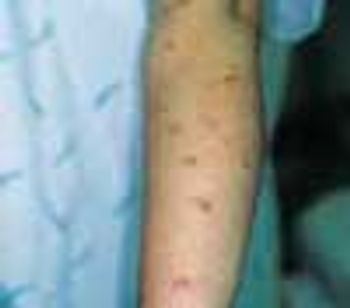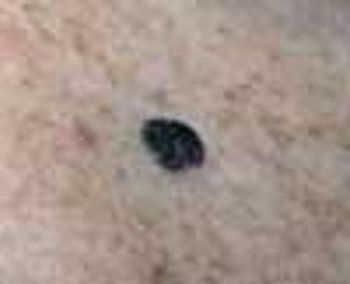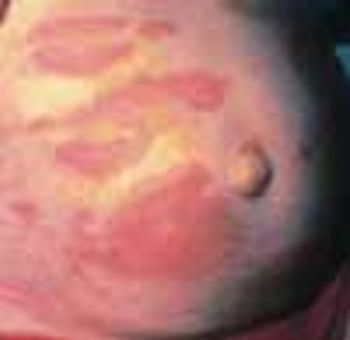Articles by Caron M. Grin, MD

In recent years, the role of the immunesystem in the pathogenesis of psoriasishas been extensively delineated. Thisresearch has spawned a new classof medications that target specific immunefactors and hold great promiseas psoriasis therapies. The Table highlightsthe significant features of 4 ofthese biologic agents.

Prolonged exposure to coldtemperatures can have a profoundeffect on the skin.When tissues are exposed toabove-freezing temperatures,localized vasoconstriction and increasedblood viscosity reduce bloodflow and decrease the amount ofoxygen available to tissues. Whentissues are exposed to freezing temperatures,water within those tissueschanges into ice crystals; this resultsin either intracellular or extracellulardamage and tissue necrosis.

These benign tumors made up of nevus cells may be flat or raised, pigmented (Figure A) or nonpigmented.

Pruritic urticarial papules and plaques of pregnancy (PUPPP). This cutaneous eruption usually occurs in the last trimester. It is seen only rarely in the postpartum period. PUPPP is more common in primigravidas but can occur in any pregnant patient.

Benign skin tumors seen in pregnant patients as well as those who are not pregnant include acrochordons, seborrheic keratoses, pyogenic granulomas, and spider angiomas. There have been reports that melanocytic nevi develop or change during pregnancy; however, a pilot study at our institution was unable to confirm this finding.

These benign vascular tumors are sometimes seen in pregnancy.

Some cutaneous conditions are unique to pregnancy and the postpartum period. Others may affect both pregnant and nonpregnant women. Familiarity with these conditions is important in the evaluation of a pregnant patient with a rash or cutaneous lesion.

A 70-year-old man who had just completeda course of trimethoprim-sulfamethoxazolefor a urinary tract infectionpresented with palpable purpuraand cutaneous erosions of acute onseton his legs (A). He also had massivescrotal edema and purpura (B).

Painful blue toes developed in a 72-year-old woman with coronary artery andperipheral vascular disease after she underwent angiography.

Tinea infections can be diag- nosed by potassium hydroxide (KOH) examination, which reveals fungal elements when a preparation of scale from a lesion-particularly the active border-is studied under a microscope; culture; and histopathologic examination of a skin biopsy specimen or nail clippings with periodic acid–Schiff stain. Culture may be warranted when a fungal infection is strongly suspected despite a negative KOH result. Unfortunately, dermatophyte cultures can take from 4 to 6 weeks to become positive; therefore, treatment decisions may have to be made before culture findings are reported. A topical antifungal is the initial therapy for tinea cruris, tinea corporis, tinea pedis, and tinea manuum. Tinea capitis, extensive tinea corporis, and tinea unguium are best treated initially with oral antifungal agents, because these infections usually do not respond to topical therapy.

A middle-aged man with"jock itch" that has failed torespond to antifungal creams.An older woman who has diffusehyperkeratosis of predominantlyweight-bearing surfaces.A young man with mildlypruritic, small, salmon pinkpapules and thick white scaleon his trunk and arms.
Latest Updated Articles

Tinea:Published: February 1st 2004 | Updated:







